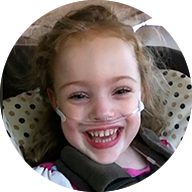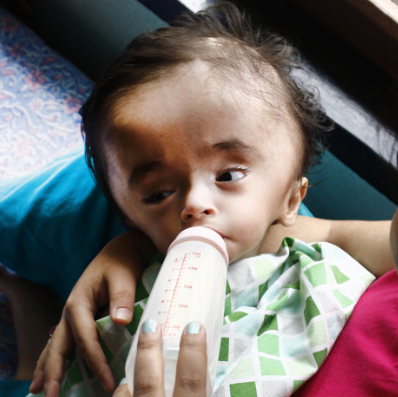If I had not witnessed it with my own eyes, I would not have believed it. How could anyone have so much bad luck? How could bad luck be so devastating?
Nora’s bad luck began even before she was born. I was young and healthy with no pregnancy risk factors. My doctor ignored me when I complained of pain contractions and heavy bleeding for weeks. He told me it was not as bad I thought and, anyway, nothing could be done. My water broke at 23 weeks as a result of prolonged bleeding and contractions.
Nora was born on December 11, 2009 – four and a half months early. She weighed 1 pound 5 oz. She was immediately taken to the Neonatal Intensive Care Unit where she spent 129 days. We were so delighted when we finally took her home after four-and-a-half months. But two months after she came home, Nora vomited and turned blue. That’s when Nora was diagnosed with pulmonary hypertension (“PH”). PH is a disease characterized by abnormally high blood pressure in the arteries of the lungs that causes the right side of the heart to work harder than normal. Nora used supplemental oxygen and oral medications to treat her PH. She needed to be on oxygen 24/7 and take oral vasodilators to help reduce the pressure in her lungs.
The doctors assured us Nora would outgrow her PH and thrive. We were very dedicated to ensuring that she ate well and stayed healthy. We had a lot of fun with Nora for the next two years – taking her to the playground, the beach, and for rides on our bikes.
But suddenly, her PH worsened. She started fainting – a serious symptom of worsening PH. The only other treatment was a continuous IV infusion of a potent vasodilator called Remodulin. In order to receive it, Nora would need a central line in her chest that would be threaded to just outside her heart. She would be hooked up to a pump 24/7 that would pump Remodulin into her. They warned us there was a risk of life-threatening infection with a central line. They told us it was imperative that we strictly followed protocol in changing her dressing and in mixing her IV medication. We studied under a nurse and practiced many times before we went home. The home nurse was also assigned to follow us at home and guide us so that we could keep Nora safe from infection.
Shortly after getting the central line, Nora developed an allergy to something in the dressing or the cleaning products. The home nurse said that we should change the dressing change protocols so that she wouldn’t have an allergy any more. So we changed protocols and sure enough, her allergy started to go away.
Nora did extremely well on IV Remodulin. She no longer fainted. She was running around the backyard and climbing stairs. She had a great appetite, was sleeping well, and was generally happy. She celebrated her third birthday with a walk around the neighborhood to see all the awesome Christmas lights. We were so happy.
Then, within two months of changing the dressing protocol, Nora developed a central line infection. They removed the line and put a temporary one in her arm. After a few days, the nurses did a dressing change and sent us home. The next day, Nora had a central line infection. Her arm was terribly swollen. When they pulled out the line, her arm was filled with pus. So the doctor switched Nora to subcutaneous Remodulin delivery that did not require a central line.
But after that, Nora continued to faint or nearly faint, and she was not herself. One morning, Nora fainted and we went to the ER. We were there for nearly nine hours. During that time, Nora was not able to eat or drink and did not receive any IV fluids. As we pulled into the ICU after nine hours of waiting, Nora crashed. She was in acute heart failure and was dying. We were told that Nora had become severely dehydrated and that had caused her blood volume to shrink. With her already exhausted heart pushed to the limit, there wasn’t enough blood to pump to the lungs.
Yet, somehow, she survived. Nora spent the next 70 days in that room in the ICU recovering from nearly dying from dehydration.
Over time, it became clear that she should get a central line to deliver a heart failure drug. So we switched Nora back to IV Remodulin at the same time. Within hours after the switch, Nora started to improve. Clearly, the SubQ (subcutaneous administration) did not work.
We had received training on how to properly wash our hands and wear masks before accessing Nora’s central line or changing her dressing. When we were in the hospital, however, we often witnessed nurses not following proper hand washing. For example, a nurse washed her hands and put on gloves. Then she went over to Nora’s bed and used her gloved hands to lower the bed rail on Nora’s bed. Then she reached to open Nora’s line. The bed rail was not sterile, but the nurse did not start her hand washing over again. We saw nurses touch monitors and pumps after washing their hands. We saw nurses open Nora’s line while leaning over Nora’s tiny chest without wearing a mask. Every time we saw nurses break the protocol, we politely asked them to wash their hands again or to put on a mask. But we could not watch the nurses every second. The pressure was unbelievable – we knew it was life or death for Nora – but we couldn’t control everything.
About six weeks after Nora got a central line, Nora developed another central line infection in the Cardiovascular Intensive Care Unit (CVICU). Hospital personnel just told us that “it happens” and “nothing can be done.”
Nora had a hard time walking for any distance and could not dance or play. But she was finally stable enough to go home. The doctors suggested replacing the temporary line in her arm with a tunneled one in her chest before she went home. When Nora came back from having the line placed, the insertion site was purple and swollen. There was blood around it and the insertion itself seemed jagged. Within 32 hours, Nora had a raging infection at the insertion site. The site became extremely swollen and the skin started pulling back from central line. Nora had a hole in her chest and I could see up into her body. Nora had to have intravenous antibiotics and this delayed her discharge home. After that infection, she was even worse.
We were finally able to bring Nora home. We had a little over two months at home together. We took Nora for lots of bike rides. She sat in a little pool on the patio and played with toys. She loved baking and cooking and doing crafts. We read many books and watched lots of DVDs. Then on Halloween, Nora did not feel well enough to go trick-or-treating. She had been looking forward to it for weeks. Within a few days, she almost fainted upon waking. We took her to the hospital. Within 48 hours of arriving at the hospital, Nora got a fever. She quickly started to crash and by that night she was in septic shock. We learned that Nora had contracted croup in the hospital. There was not much we could do but wait and hope and pray.
Nora held on for nearly two weeks. Unfortunately, she was the victim of more preventable errors. A nurse gave her a double dose of a potent diuretic that sent her into acute dehydration and heart failure. Someone else mistakenly discontinued her IV nutrition for three days until I discovered it. Nora was fighting for her life without any nutrition at all.
But one day, Nora’s heart rate started going higher and it would not come down. Nora was uncomfortable and scared. She reached up and to me and said “hold me.” My husband was right there next to me. I held her tight and she said “please help me feel better.” Then I pulled her head down on to my shoulder. She seemed to lose consciousness and she slowly slipped away. We cradled her in our arms and looked at her beautiful face as she took her last breaths. Our beautiful, compassionate, smart, funny daughter who had everything going for her – except luck – was gone.







